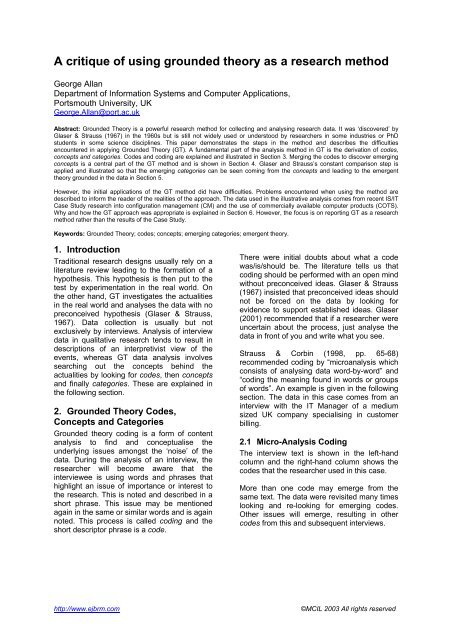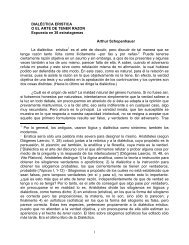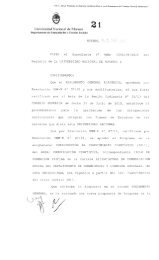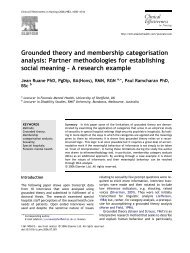critique of grounded theory
Create successful ePaper yourself
Turn your PDF publications into a flip-book with our unique Google optimized e-Paper software.
A <strong>critique</strong> <strong>of</strong> using <strong>grounded</strong> <strong>theory</strong> as a research method<br />
George Allan<br />
Department <strong>of</strong> Information Systems and Computer Applications,<br />
Portsmouth University, UK<br />
George.Allan@port.ac.uk<br />
Abstract: Grounded Theory is a powerful research method for collecting and analysing research data. It was ‘discovered’ by<br />
Glaser & Strauss (1967) in the 1960s but is still not widely used or understood by researchers in some industries or PhD<br />
students in some science disciplines. This paper demonstrates the steps in the method and describes the difficulties<br />
encountered in applying Grounded Theory (GT). A fundamental part <strong>of</strong> the analysis method in GT is the derivation <strong>of</strong> codes,<br />
concepts and categories. Codes and coding are explained and illustrated in Section 3. Merging the codes to discover emerging<br />
concepts is a central part <strong>of</strong> the GT method and is shown in Section 4. Glaser and Strauss’s constant comparison step is<br />
applied and illustrated so that the emerging categories can be seen coming from the concepts and leading to the emergent<br />
<strong>theory</strong> <strong>grounded</strong> in the data in Section 5.<br />
However, the initial applications <strong>of</strong> the GT method did have difficulties. Problems encountered when using the method are<br />
described to inform the reader <strong>of</strong> the realities <strong>of</strong> the approach. The data used in the illustrative analysis comes from recent IS/IT<br />
Case Study research into configuration management (CM) and the use <strong>of</strong> commercially available computer products (COTS).<br />
Why and how the GT approach was appropriate is explained in Section 6. However, the focus is on reporting GT as a research<br />
method rather than the results <strong>of</strong> the Case Study.<br />
Keywords: Grounded Theory; codes; concepts; emerging categories; emergent <strong>theory</strong>.<br />
1. Introduction<br />
Traditional research designs usually rely on a<br />
literature review leading to the formation <strong>of</strong> a<br />
hypothesis. This hypothesis is then put to the<br />
test by experimentation in the real world. On<br />
the other hand, GT investigates the actualities<br />
in the real world and analyses the data with no<br />
preconceived hypothesis (Glaser & Strauss,<br />
1967). Data collection is usually but not<br />
exclusively by interviews. Analysis <strong>of</strong> interview<br />
data in qualitative research tends to result in<br />
descriptions <strong>of</strong> an interpretivist view <strong>of</strong> the<br />
events, whereas GT data analysis involves<br />
searching out the concepts behind the<br />
actualities by looking for codes, then concepts<br />
and finally categories. These are explained in<br />
the following section.<br />
2. Grounded Theory Codes,<br />
Concepts and Categories<br />
Grounded <strong>theory</strong> coding is a form <strong>of</strong> content<br />
analysis to find and conceptualise the<br />
underlying issues amongst the ‘noise’ <strong>of</strong> the<br />
data. During the analysis <strong>of</strong> an interview, the<br />
researcher will become aware that the<br />
interviewee is using words and phrases that<br />
highlight an issue <strong>of</strong> importance or interest to<br />
the research. This is noted and described in a<br />
short phrase. This issue may be mentioned<br />
again in the same or similar words and is again<br />
noted. This process is called coding and the<br />
short descriptor phrase is a code.<br />
There were initial doubts about what a code<br />
was/is/should be. The literature tells us that<br />
coding should be performed with an open mind<br />
without preconceived ideas. Glaser & Strauss<br />
(1967) insisted that preconceived ideas should<br />
not be forced on the data by looking for<br />
evidence to support established ideas. Glaser<br />
(2001) recommended that if a researcher were<br />
uncertain about the process, just analyse the<br />
data in front <strong>of</strong> you and write what you see.<br />
Strauss & Corbin (1998, pp. 65-68)<br />
recommended coding by “microanalysis which<br />
consists <strong>of</strong> analysing data word-by-word” and<br />
“coding the meaning found in words or groups<br />
<strong>of</strong> words”. An example is given in the following<br />
section. The data in this case comes from an<br />
interview with the IT Manager <strong>of</strong> a medium<br />
sized UK company specialising in customer<br />
billing.<br />
2.1 Micro-Analysis Coding<br />
The interview text is shown in the left-hand<br />
column and the right-hand column shows the<br />
codes that the researcher used in this case.<br />
More than one code may emerge from the<br />
same text. The data were revisited many times<br />
looking and re-looking for emerging codes.<br />
Other issues will emerge, resulting in other<br />
codes from this and subsequent interviews.<br />
http://www.ejbrm.com<br />
©MCIL 2003 All rights reserved
2 George Allan<br />
Table 1 : Examples <strong>of</strong> early codes in <strong>grounded</strong> <strong>theory</strong> analysis <strong>of</strong> Case Study Y data<br />
Interview Text<br />
From my perspective<br />
the main challenge is<br />
in changes in technology<br />
or the product improvement<br />
done by the COTS supplier.<br />
You<br />
can never guarantee that<br />
if you are buying several,<br />
they will all be the same.<br />
Yes,<br />
when you come to buying PCs<br />
a lot <strong>of</strong> our products now are delivered with the<br />
s<strong>of</strong>tware already loaded on the PCs<br />
that causes you to go through an inspection.<br />
We weren’t happy,<br />
it was costing us extra money.<br />
Last year this part <strong>of</strong> Company Y organised a forum<br />
workshop seminar on COTS,<br />
and as part <strong>of</strong> that we did a survey <strong>of</strong> a number <strong>of</strong> our<br />
projects on problems and issues with using COTS<br />
the short time that components become obsolete.<br />
Codes<br />
Personal view<br />
Assertion<br />
Changes in technology<br />
Changes in product<br />
Assertion<br />
Changes by Supplier<br />
Pronoun shift<br />
Assertion<br />
Uncertainty<br />
Procurement<br />
Product consistency<br />
Necessary condition<br />
Affirmation<br />
Procurement <strong>of</strong> hardware<br />
Integrated products<br />
Hardware<br />
S<strong>of</strong>tware<br />
Extra work<br />
Costs in human effort<br />
Costs in time<br />
Dissatisfaction<br />
Costs in money<br />
Extra work<br />
Action due to COTS shortfall<br />
Extra work<br />
Implementation difficulty<br />
Short time to obsolescence<br />
2.2 Difficulties with Micro-Analysis<br />
Coding<br />
This analysis technique <strong>of</strong> coding by<br />
microanalysis <strong>of</strong> the data, word-by-word and<br />
line-by-line, had two drawbacks. Firstly, it was<br />
very time consuming. The transcription <strong>of</strong> each<br />
interview contained a mass <strong>of</strong> data that had to<br />
be studied to locate the information relevant to<br />
the research topic. Secondly, it led to<br />
confusion at times. Dividing the data into<br />
individual words caused the analysis<br />
sometimes to become lost within the minutia <strong>of</strong><br />
data. So many words being picked over<br />
individually led to confusion. There were times<br />
when the focus was lost. Doubts were<br />
experienced about what it was that we were<br />
looking for.<br />
Further reference to the <strong>grounded</strong> <strong>theory</strong><br />
literature uncovered the rift between Glaser<br />
and Straus on this issue. Glaser (1992, p. 40)<br />
condemned this micro-approach as producing<br />
an “over-conceptualisation”. This encapsulated<br />
exactly what was being experienced and the<br />
analysis, from this point on, followed Glaser<br />
(1992). That is, identifying key points (rather<br />
than individual words) and allowing concepts<br />
to emerge. The selection <strong>of</strong> points key to<br />
addressing research questions is in line with<br />
qualitative coding analysis (Miles & Huberman,<br />
1984) as a protection against data overload.<br />
Dey (1993, pp. 94-97) talks <strong>of</strong> “bits <strong>of</strong> data”<br />
that are considered important. Therefore, key<br />
points in each interview were identified and<br />
marked ready for analysis and coding.<br />
2.3 Key Point Coding<br />
The points regarded as important to the<br />
investigation were identified in the transcripts,<br />
highlighted in italic font and given an identifier<br />
attributed sequentially starting at the first<br />
interview and continuing on through<br />
subsequent interviews to give P1, P2, and so<br />
on where ‘P’ indicates ‘key point’. To<br />
differentiate key points made longitudinally in<br />
subsequent case studies, these identifiers<br />
were distinguished with a suffix X, Y or Z. For<br />
example, key point 8 made by the staff in case<br />
study X appears as P X 8. Thus it is possible to<br />
trace back through the interview transcriptions<br />
to the actual content and context <strong>of</strong> each key<br />
point. The key point identifiers are shown in<br />
the left-hand column <strong>of</strong> Table 2. The text <strong>of</strong> the<br />
key point is shown in the middle column and<br />
the code in the right-hand column.<br />
http://www.ejbrm.com<br />
©MCIL 2003 All rights reserved
Electronic Journal <strong>of</strong> Business Research Methods, Volume 2 Issue 1 (2003) 1-10 3<br />
Table 2: Examples <strong>of</strong> Key points and codes from the data in Case Study X<br />
Id Key Point Code<br />
P X 1 Manual standards on CM were set up as a result <strong>of</strong> a<br />
Requirements Study for better control <strong>of</strong> in-house s<strong>of</strong>tware<br />
development.<br />
control <strong>of</strong> s<strong>of</strong>tware<br />
s<strong>of</strong>tware<br />
development<br />
P X 2 Company X required a CM system at minimum cost. requirement for a CM system<br />
P X 2a Maestro II was selected as CM tool CM tool<br />
P X 3 End-to-end CM is defined as the full life-cycle from conception CM system<br />
stage through to and including operational maintenance.<br />
P X 4 Scheduling changes was regarded as an essential and integral<br />
part <strong>of</strong> the s<strong>of</strong>tware process.<br />
changes<br />
s<strong>of</strong>tware process<br />
P X 5 CM Projects Department has been <strong>of</strong>ficially formed. recognition <strong>of</strong> CM<br />
P X 5a All future work will mandate CM on all data streams. recognition <strong>of</strong> CM<br />
support for CM<br />
P X 6 Processes equate to Configuration identification and<br />
CM process<br />
configuration control.<br />
P X 7 CM audits are used to bring other s<strong>of</strong>tware systems under CM CM process<br />
control.<br />
P X 8 Status Accounting is used to report monthly to the Project Board. CM process<br />
P X 9 Main difficulty is getting people to buy-in to CM. people difficulty<br />
P X 10 3 rd parties have a preconceived set <strong>of</strong> established tools and are people difficulty tool difficulty<br />
P X 11<br />
P X 12<br />
P X 13<br />
P X 13a<br />
not willing to see the in-house point <strong>of</strong> view.<br />
Developers saw CM as a control mechanism rather than a helpful<br />
tool.<br />
People in the rapid application development (RAD) team thought<br />
that CM slows down their work and perceived CM as “just<br />
another layer <strong>of</strong> administration”.<br />
Involving s<strong>of</strong>tware developers in the CM set-up processes can<br />
solve problems with the perception <strong>of</strong> CM.<br />
CM perception problems can be solved by involving people in<br />
discussions<br />
not helpful<br />
control<br />
people difficulty<br />
slows down work<br />
administration<br />
resistance to CM<br />
people issue<br />
people issue<br />
P X 22 S<strong>of</strong>tware is controlled in pre-production and production using CM. control <strong>of</strong> s<strong>of</strong>tware<br />
P X 27 Company X had a need to develop a version control system for<br />
s<strong>of</strong>tware. [Comment: This implies that there is not one available<br />
on the open market]<br />
tool difficulty<br />
s<strong>of</strong>tware version control<br />
The key points P X 2a, P X 5a and P X 13a arose<br />
on a second, third or subsequent pass <strong>of</strong> the<br />
data. Many key points had been labelled with<br />
their unique identifiers and this avoided resequencing<br />
on every pass. Revisiting the data<br />
and creating multiple passes was to become a<br />
common occurrence.<br />
The codes are then analysed and those that<br />
relate to a common theme are grouped<br />
together. This higher order commonality, is<br />
called a concept. Other concepts emerge from<br />
other groupings <strong>of</strong> the codes. An illustration is<br />
given in Section 4. Concepts are then grouped<br />
and regrouped to find yet higher order<br />
commonalities called categories illustrated in<br />
Section 5. It is these concepts and categories<br />
that lead to the emergence <strong>of</strong> a <strong>theory</strong>. If the<br />
data has been analysed without a<br />
preconceived <strong>theory</strong> or hypothesis, that <strong>theory</strong><br />
is truly <strong>grounded</strong> in the data because it came<br />
from nowhere else.<br />
3. The Emergence <strong>of</strong> Concepts<br />
The code “s<strong>of</strong>tware development” emerged<br />
from P X 1. The codes from all other key points<br />
were compared with this to see if similar codes<br />
occurred <strong>of</strong>ten. The following codes were<br />
considered to have commonality: “s<strong>of</strong>tware<br />
development” from P X 1; “s<strong>of</strong>tware process”<br />
from P X 4; “control <strong>of</strong> s<strong>of</strong>tware” from P X 22;<br />
s<strong>of</strong>tware version control from P X 27. The<br />
common characteristic is “Used for control <strong>of</strong><br />
s<strong>of</strong>tware development” and this was the first<br />
concept to emerge from the data. This was<br />
noted in Table 3.<br />
From P X 12 emerged “slows down work”, layer<br />
<strong>of</strong> “administration” and “resistance to CM”.<br />
Combining these with P X 13 and P X 13a led to<br />
the concept <strong>of</strong> “Perceived as extra work”.<br />
Other combinations <strong>of</strong> codes led to further<br />
concepts and these were added to Table 3.<br />
Confidence in the process <strong>of</strong> coding grew and<br />
uncertain subsided with experience <strong>of</strong> the<br />
method.<br />
http://www.ejbrm.com<br />
©MCIL 2003 All rights reserved
4 George Allan<br />
The process <strong>of</strong> comparing the codes with each<br />
other, to find higher order commonality,<br />
produced the concepts from the codes. The<br />
concepts from Case Study X are summarised<br />
below.<br />
Table 3 : Emergence <strong>of</strong> concepts from the<br />
codes in Case Study X data<br />
Used for control <strong>of</strong> s<strong>of</strong>tware development –<br />
P X 1, P X 4, P X 11, P X 22, P X 27<br />
Perceived as extra work – P X 12, P X 13, P X 13a<br />
Recognised need for a CM system – P X 2, P X 3<br />
CM recognised by company – P X 5, P X 5a, P X 17,<br />
P X 19, P X 23, P X 24, P X 29<br />
Use <strong>of</strong> established CM processes – P X 6, P X 7,<br />
P X 8, P X 30<br />
Difficult to get people to buy-in – P X 9, P X 10<br />
Tools do not have the correct functionality –<br />
P X 10<br />
CM active seen as part <strong>of</strong> other activities – P X 15,<br />
P X 16, P X 26, P X 30, P X 31, P X 33, P X 34<br />
Used for control at system level – P X 4, P X 11,<br />
P X 18, P X 20, P X 23, P X 24, P X 27, P X 32, P X 35<br />
People support is needed – P X 9, P X 25, P X 29<br />
People are reluctant to practise CM – P X 11, P X 28<br />
CM tool difficulties – P X 10, P X 27<br />
Pro<strong>of</strong> <strong>of</strong> control – P X 33, P X 34, P X 34a<br />
Gaser & Strauss (1967, p. 37) insisted that<br />
there is little point in looking for ideas<br />
established by other researchers, as this<br />
“hinders searching for new concepts”.<br />
Therefore, each key point was analysed for<br />
Used for control <strong>of</strong> s<strong>of</strong>tware<br />
development<br />
Used for control at system level<br />
Pro<strong>of</strong> <strong>of</strong> control<br />
new concepts relevant to the current research.<br />
It is permissible to note support for a concept<br />
that is emerging from the current research.<br />
This provides important substantiation <strong>of</strong> that<br />
concept.<br />
4. Categories<br />
By comparing each concept in turn with all<br />
other concepts, further commonalities are<br />
found which form the even broader categories.<br />
Glaser & Strauss (1967, pp. 105-115)<br />
described this method <strong>of</strong> continually comparing<br />
concepts with each other as their “constant<br />
comparative method”.<br />
4.1 The Emergence <strong>of</strong> Categories from<br />
Case Study X<br />
By applying the constant comparison<br />
technique to each concept in turn, a common<br />
theme were found amongst the following<br />
concepts:<br />
Used for control <strong>of</strong> s<strong>of</strong>tware development;<br />
Used for control at system level;<br />
Pro<strong>of</strong> <strong>of</strong> control; Need to control the<br />
introduction <strong>of</strong> s<strong>of</strong>tware<br />
These share the theme <strong>of</strong> CM AS A<br />
CONTROL MECHANISM. This was the first<br />
category to emerge from the data and is<br />
demonstrated diagrammatically in Figure 1.<br />
CM as a control mechanism<br />
Need to control the introduction<br />
<strong>of</strong> COTS s<strong>of</strong>tware<br />
Figure 1 : Diagrammatical emergence <strong>of</strong> the category “CM as a control mechanism”<br />
By comparing the other concepts and grouping People are reluctant to practise CM, Perceived as<br />
extra work, Getting people to buy-in and Tools do not have the correct functionality a category<br />
emerged in Figure 2 as “Difficulties with CM”.<br />
People are reluctant to practice CM<br />
Perceived as extra work<br />
Getting people to buy-in<br />
Tools do not have the<br />
correct functionality<br />
Difficulties with CM<br />
Figure 2 : Diagrammatical emergence <strong>of</strong> the category “Difficulties with CM”<br />
http://www.ejbrm.com<br />
©MCIL 2003 All rights reserved
Electronic Journal <strong>of</strong> Business Research Methods, Volume 2 Issue 1 (2003) 1-10 5<br />
Grouping People support is needed, Use <strong>of</strong> established processes and There is a need for CM in<br />
Figure 3 gave the category “CM practices”.<br />
People support is needed<br />
Use <strong>of</strong> established processes<br />
CM practices<br />
There is a need for CM<br />
Figure 3 : Diagrammatical emergence <strong>of</strong> the category “CM practices”<br />
Grouping Tool selection with CM tool difficulties in Figure 4 gave “Tools issues”.<br />
Tool selection<br />
CM tool difficulties<br />
Tools issues<br />
Figure 4 : Diagrammatical emergence <strong>of</strong> the category “Tools issues”<br />
These categories and their relevant concepts are displayed in Table 4.<br />
Table 4: Emergence <strong>of</strong> categories from the concepts in the data from Case Study X<br />
CM AS A CONTROL MECHANISM<br />
Used for control <strong>of</strong> s<strong>of</strong>tware development - P X 1, P X 4, P X 11, P X 22, P X 27<br />
Used for control at system level – P X 4, P X 11, P X 18, P X 20, P X 23, P X 24, P X 27, P X 32, P X 35<br />
Pro<strong>of</strong> <strong>of</strong> control – P X 33, P X 34, P X 34a<br />
Need to control the introduction <strong>of</strong> COTS s<strong>of</strong>tware – P X 35, P X 36, P X 37<br />
DIFFICULTIES WITH CM<br />
Getting people to buy-in – P X 9, P X 10, P X 11, P X 28<br />
Perceived as extra work – P X 12, P X 13, P X 13a<br />
Tools do not have the correct functionality – P X 10<br />
CM PRACTICES<br />
Use <strong>of</strong> established CM processes – P X 6, P X 7, P X 8, P X 30<br />
There is a need for CM – P X 2, P X 3, P X 5, P X 5a, P X 17, P X 19, P X 23, P X 24, P X 29<br />
People support is being accomplished but still a problem – P X 9, P X 11, P X 25, P X 28, P X 29<br />
TOOLS ISSUES<br />
CM tool selection – P X 2a<br />
CM tool difficulties – P X 10, P X 27<br />
Data from two other case studies were<br />
analysed to further establish or otherwise<br />
these categories and discover new categories.<br />
4.2 Emergence <strong>of</strong> categories from<br />
Case Study Y<br />
The second case study was a manufacturer<br />
and supplier <strong>of</strong> equipment computer. The<br />
company structure was divisional. The analysis<br />
proceeded by comparing the new key points<br />
with the concepts and categories thus far<br />
established. New concepts will appear. This<br />
evidence added further substance in what<br />
Glaser & Straus (1967) called substantiation<br />
leading to substantive <strong>theory</strong>.<br />
Table 5: Emergence <strong>of</strong> concepts and<br />
categories from the data from Case Study Y<br />
CM AS A CONTROL MECHANISM<br />
CM is used for control <strong>of</strong> s<strong>of</strong>tware<br />
development - P Y 2, P Y 8<br />
CM is used for control at system level - P Y 3,<br />
P Y 4, P Y 12a<br />
Pro<strong>of</strong> <strong>of</strong> control<br />
DIFFICULTIES WITH CM<br />
Getting people to buy-in - P Y 5, P Y 6, P Y 11<br />
Perceived as extra work - P Y 7, P Y 8<br />
Tools do not have the correct functionality - P Y 9,<br />
P Y 13<br />
CM PRACTICES<br />
Use <strong>of</strong> established CM processes - P Y 4, P Y 8<br />
There is a need for CM - P Y 1, P Y 2, P Y 3, P Y 4,<br />
P Y 12a<br />
People support<br />
Relationship between CM and project<br />
management - P Y 3, P Y 4, P Y 10, P Y 14, P Y 5a<br />
Cradle-to-grave concept <strong>of</strong> CM - P Y 12a, P Y 3<br />
http://www.ejbrm.com<br />
©MCIL 2003 All rights reserved
6 George Allan<br />
TOOLS ISSUES<br />
CM tool selection - P Y 12<br />
CM tool difficulties - P Y 9, P Y 13<br />
The two concepts ‘Pro<strong>of</strong> <strong>of</strong> control’ and<br />
‘People support’ had no support from this data<br />
analysis. However, two new concepts emerged<br />
as:<br />
‘Use <strong>of</strong> CM in project management’ - P Y 3, P Y 4,<br />
P Y 10, P Y 14<br />
‘A cradle-to-grave concept <strong>of</strong> CM’ - P Y 12a, P Y 3<br />
These new categories were integrated into the<br />
list <strong>of</strong> emerging categories.<br />
4.3 Emergence <strong>of</strong> categories from<br />
Case Study Z<br />
The third case study was a medium sized<br />
company employing approximately 500 staff<br />
providing a service function <strong>of</strong> customer billing<br />
to a national conglomerate organisation. The<br />
organisational chart <strong>of</strong> this company showed<br />
functional areas which were strictly defined<br />
with a rigorous reporting hierarchy. The<br />
organisation was bureaucratic with welldefined<br />
management levels.<br />
The analysis <strong>of</strong> the key points into their codes<br />
continued as before by searching for key<br />
points in the data and identifying codes. A few<br />
key points are illustrated in Table 6 as<br />
examples.<br />
Table 6: Example <strong>of</strong> the key points and codes from Case Study Z<br />
Id Key Point Open Codes<br />
P Z 1 Project people are the customers <strong>of</strong> CM. CM in project management<br />
P Z 2 CM is being used actively. need for CM<br />
P Z 3 There is difficulty in capturing the configuration <strong>of</strong> people difficulties<br />
some systems that SD&E are not directly<br />
responsible for.<br />
P Z 4 The biggest difficulty has been to identify how much people difficulties<br />
control CM should have over systems.<br />
P Z 5 Another difficulty is how to achieve CM control people difficulties<br />
consistently.<br />
P Z 6 There is resistance to CM from the owners <strong>of</strong> resistance<br />
systems.<br />
people difficulties<br />
P Z 7 Documentation becomes part <strong>of</strong> the CM system. CM process<br />
P Z 2 There should be more <strong>of</strong> this research going on. more research<br />
3<br />
P Z 2<br />
4<br />
Outsiders see CM as really boring.<br />
people difficulty<br />
A new concept emerged from P Z 23, that <strong>of</strong><br />
“More research needed in CM”.<br />
This new category was integrated into the list<br />
<strong>of</strong> emerging categories and the wording <strong>of</strong><br />
existing concepts adjusted where necessary to<br />
reflect the additions to the data accumulated.<br />
For example “Getting people to buy-in”<br />
became “People difficulties” and “difficulties<br />
with tools” was reworded as “Technical<br />
difficulties” to reflect the totality <strong>of</strong> data<br />
collected without loss <strong>of</strong> relevance or focus.<br />
As subsequent interviews took place, in any<br />
case study, the process <strong>of</strong> constant<br />
comparison continued. Key points identified in<br />
the transcripts were compared with concepts<br />
and categories so far established and<br />
adjustments made to categories to reflect<br />
accumulated findings. These, in turn, were<br />
then used in subsequent analysis. Emerging<br />
categories are show diagrammatically in Figure<br />
5.<br />
5. Emerging Theory<br />
By linking the categories and investigating the<br />
connections between concepts the <strong>theory</strong><br />
emerges. From Figure 5 the categories were:<br />
CM as a control mechanism, Difficulties<br />
with CM, CM practices and Tools issues.<br />
There is not space in this illustrative paper to<br />
analyse fully the connections between<br />
categories and the concepts. This can be<br />
obtained on request. However, the emergent<br />
<strong>grounded</strong> <strong>theory</strong> <strong>of</strong> computer CM can be<br />
summarised as follows.<br />
http://www.ejbrm.com<br />
©MCIL 2003 All rights reserved
Electronic Journal <strong>of</strong> Business Research Methods, Volume 2 Issue 1 (2003) 1-10 7<br />
“Configuration management is a set <strong>of</strong><br />
processes that collectively form a control<br />
mechanism to assist the effective operations <strong>of</strong><br />
computer systems. The usefulness <strong>of</strong> CM will<br />
be impaired if the benefits from it are not<br />
recognised and supported among technical<br />
and business personnel. A sophisticated CM<br />
system will assist in identifying where and how<br />
components interact and the relationships<br />
between them so that a new component may<br />
be implemented in the correct place and<br />
continue the harmony <strong>of</strong> the whole system.<br />
However, Currently available CM tools can be<br />
difficult to use. It is therefore important to<br />
select appropriate tools with care.<br />
Figure 5. : Emergent categories derived from <strong>grounded</strong> <strong>theory</strong> analysis <strong>of</strong> interview data in 3 case studies 1999-<br />
2002<br />
6. Discussion<br />
The reader will see that the four categories<br />
and some <strong>of</strong> the concepts are embedded in<br />
this summary. This is how GT leads from<br />
codes to concepts to categories to <strong>theory</strong>. The<br />
resultant <strong>theory</strong> does not need separate<br />
justification and testing because it came from<br />
live data. More data will be collected in future<br />
case studies and the <strong>theory</strong> will be improved<br />
upon and amended to reflect real life.<br />
6.1 Grounded Theory and Literature<br />
Search<br />
Some people have interpreted the GT method<br />
to mean fieldwork before literature search but<br />
this is a misconception <strong>of</strong> the original premise<br />
put forward by Glaser & Strauss (1967, p. 169)<br />
who encouraged researchers to “use any<br />
material bearing in the area”. This is taken to<br />
include the writings <strong>of</strong> other authors. Strauss &<br />
Corbin (1998) saw the use <strong>of</strong> literature as a<br />
basis <strong>of</strong> pr<strong>of</strong>essional knowledge and referred<br />
to it as literature sensitivity and Dey (1993, p.<br />
66) saw it as “accumulated knowledge”.<br />
The research used to illustrate the GT method<br />
investigated current practices in large UK<br />
organisations when maintaining computer<br />
systems supporting their core businesses in<br />
the commercial world. A review <strong>of</strong> the relevant<br />
literature established current thinking in the<br />
areas <strong>of</strong> configuration management and the<br />
use <strong>of</strong> commercially available components.<br />
However, this literature review did not lead to<br />
any hypotheses <strong>of</strong> sufficient interest. Combine<br />
this with the fact that GT investigates<br />
actualities in the real world (which CM<br />
practices are) and the <strong>grounded</strong> <strong>theory</strong><br />
approach was appropriate for this research.<br />
The choice <strong>of</strong> case study as the research<br />
method to collect the data is justified in the<br />
next section.<br />
6.2 Grounded Theory and Case<br />
Studies<br />
The use <strong>of</strong> the case study as a research<br />
paradigm is well known. Yin (1994) advocated<br />
case study research to investigate<br />
contemporary phenomena within real-life<br />
contexts especially when the boundaries<br />
between phenomena and contexts are not<br />
clear. In this research into CM practices, the<br />
http://www.ejbrm.com<br />
©MCIL 2003 All rights reserved
8 George Allan<br />
boundaries are not clearly defined between<br />
phenomena (the practices) and contexts (the<br />
companies) or within phenomena, or within<br />
contexts.<br />
However, there are certain tensions between<br />
Yin’s version <strong>of</strong> the case study paradigm and<br />
the GT methodology. Yin (1994, p. 13)<br />
suggested that the case study "benefits from<br />
the prior development <strong>of</strong> theoretical<br />
propositions to guide data collection and<br />
analysis" whereas Glaser & Strauss (1967)<br />
insisted that a <strong>grounded</strong> <strong>theory</strong> approach<br />
should have no pre-conceived ideas or<br />
hypothesis.<br />
A criticism <strong>of</strong> the case study as a research<br />
method is that there can be no generalisation<br />
<strong>of</strong> findings but Yin (1994) defended the<br />
position that case studies do lead to building<br />
theories applicable in the world at large.<br />
Grounded <strong>theory</strong> specifically attempts to<br />
investigate the real world, usually through<br />
interview data. It discovers the concepts<br />
<strong>grounded</strong> in the data and uses those concepts<br />
to build <strong>theory</strong>. The use <strong>of</strong> both these<br />
methods, therefore, minimises this criticism.<br />
There is, therefore, no real anomaly between<br />
the use <strong>of</strong> case study and the use <strong>of</strong> GT. Both<br />
research methods collect data using<br />
interviews.<br />
6.3 Grounded Theory and Interviews<br />
Greater reliability can be placed on the data<br />
gathered in an interview over that gathered by<br />
a list <strong>of</strong> self-completion questions in a survey.<br />
In a face-to-face situation an experienced<br />
interviewer can tell whether the respondent is<br />
the appropriate person to answer the<br />
questions. Respondents are able to discuss<br />
issues in detail (Hague, 1987) and it is<br />
possible to use diagrams to clarify points.<br />
Another possible criticism <strong>of</strong> GT is a lack <strong>of</strong><br />
rigour due to careless interview techniques<br />
and the introduction <strong>of</strong> bias. In this research<br />
the case study interviews were guided to avoid<br />
leading questions and the introduction <strong>of</strong> bias.<br />
A working awareness <strong>of</strong> bias is imperative in<br />
all interview research. Transcriptions were<br />
checked for context and content accuracy<br />
before analysis began. These precautions and<br />
the fact that conclusions drawn are <strong>grounded</strong><br />
in actual data helps minimise the risk <strong>of</strong> bias.<br />
A real advantage <strong>of</strong> GT is that analysis starts<br />
as soon as data collection begins in the first<br />
interview. Glaser (2002) holds that analysis<br />
can start during the first interview if the<br />
researcher identifies concepts that are striking<br />
at that time. However, it is not sufficient simply<br />
to inspect data and label interesting points, the<br />
data have to be analysed in a systematic and<br />
rigorous manner to discover the concepts<br />
leading to the categories. This is an iterative<br />
process that requires a great deal <strong>of</strong> time,<br />
patience and analytic skill.<br />
7. Conclusions<br />
These conclusions are written as a personal<br />
reflection <strong>of</strong> my experiences <strong>of</strong> GT.<br />
Glaser & Strauss (1967) emphasis that the<br />
researcher should have “no preconceived<br />
ideas” when collecting and analysing data. I<br />
had two problems with this. Firstly, there has to<br />
be some agenda for research by interview.<br />
Busy people in industry and commerce expect<br />
meetings to have an agenda and research<br />
projects to be scoped. Time and resource<br />
constraints prohibit unfocused investigation. It<br />
is clearly not possible to investigate specific<br />
working practices in UK industry without some<br />
focus to work toward but this is not what<br />
Glaser & Strauss meant. They were referring<br />
to preconceived bias, dogma and mental<br />
baggage which, in this case, may be taken to<br />
be preconceived ideas about working practices<br />
embedded in the researcher’s mind (Glaser<br />
2002). Interviews were therefore focused using<br />
open stimuli such as “Tell me about the<br />
working practices to do with CM” or “What<br />
happens to new components?” Extra time then<br />
had to be budgeted for the analysis as the<br />
interview transcripts were voluminous.<br />
Secondly, I was looking for a clearly defined<br />
coding process or mechanism. Grounded<br />
Theory demands more in analysis than simple<br />
inspection <strong>of</strong> the data. However, Glaser &<br />
Strauss (1967) and later Glaser (1978; 1992)<br />
do not instruct the reader in a prescribed<br />
mechanism for performing the coding. They<br />
describe the conceptualisation <strong>of</strong> coding. I was<br />
not sure what I was looking for. What was “a<br />
code”? Was it a statement <strong>of</strong> importance, in<br />
which case, what was important if we were to<br />
have no preconceived ideas? In previous<br />
research I had always had a hypothesis on<br />
which to focus. Was a code a statement <strong>of</strong><br />
interest? At the outset I was unsure what was<br />
<strong>of</strong> interest.<br />
Both these difficulties were overcome by<br />
identifying the Key Points in the interview data<br />
and concentrating the analysis on these.<br />
However, another difficulty experienced was in<br />
knowing when coding should be ended. Did<br />
every relevant statement in the text have to be<br />
http://www.ejbrm.com<br />
©MCIL 2003 All rights reserved
Electronic Journal <strong>of</strong> Business Research Methods, Volume 2 Issue 1 (2003) 1-10 9<br />
identified and used? Was one statement<br />
enough if made by a person in authority? Was<br />
it enough to have three <strong>of</strong> four statements<br />
containing the same code. How many times<br />
did a code have to occur to be substantive.<br />
When performing the constant comparisons<br />
between concepts to find emerging categories,<br />
how many concepts need to be included to<br />
form a category. Glaser (2002) advises that<br />
“one is enough if it is significant”. One concept<br />
can contribute to the emerging <strong>theory</strong>.<br />
I was also uncertain about when to finishing<br />
the analysis. Glaser (1978) discusses<br />
saturation as the key to knowing when to stop.<br />
However, it took many attempts before I was at<br />
all confident when to stop the analysis and<br />
form the <strong>theory</strong>. Latterly I found that the <strong>theory</strong><br />
could be allowed to emerge right from the start.<br />
I use the term “allowed to emerge” to mean<br />
that concepts and categories should be noted<br />
and merged as soon as they are noticed and<br />
this is the start <strong>of</strong> the <strong>theory</strong>. The researchers’<br />
mind-sets are used to waiting until all data are<br />
collected before starting analysis and all<br />
analysis is completed before drawing<br />
conclusions. In GT this is not the case and this<br />
needs to be understood and appreciated.<br />
Analysis can start with the first interview.<br />
In conclusion, the Grounded Theory method is<br />
recommend as a powerful way to collect and<br />
analyse data and draw meaningful<br />
conclusions. This recommendation applies to<br />
any researcher in the hard sciences as well as<br />
the social sciences.<br />
References<br />
Dey, I. (1993) Qualitative Data Analysis,<br />
London, Routledge<br />
Glaser, B.G. & Strauss, A.L. (1967) The<br />
Discovery <strong>of</strong> Grounded Theory, New<br />
York, Aldine<br />
Glaser, B.G. (1978) Theoretical Sensitivity, Mill<br />
Valley California, Sociology Press<br />
Glaser, B.G. (1992) Emergence vs Forcing :<br />
Basics <strong>of</strong> Grounded Theory, Mill Valley,<br />
CA, Sociology Press<br />
Glaser, B.G. (2002) Private conversations in<br />
Paris<br />
Hague, P. (1987) The Industrial Market<br />
Research Handbook, London, Kogan<br />
Press<br />
Miles, M.B. & Huberman, A.M. (1984)<br />
Qualitative Data Analysis - A Sourcebook<br />
<strong>of</strong> New Methods, California, Sage<br />
Strauss, A.L. & Corbin, J. (1998) Basics <strong>of</strong><br />
Qualitative research techniques and<br />
Procedures for Developing Grounded<br />
Theory, USA, Sage<br />
Yin, R. (1994) Case study research: Design<br />
and methods (2nd ed.), Beverly Hills, CA,<br />
Sage Publishing.<br />
http://www.ejbrm.com<br />
©MCIL 2003 All rights reserved
http://www.ejbrm.com<br />
©MCIL 2003 All rights reserved












